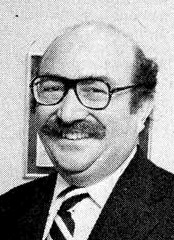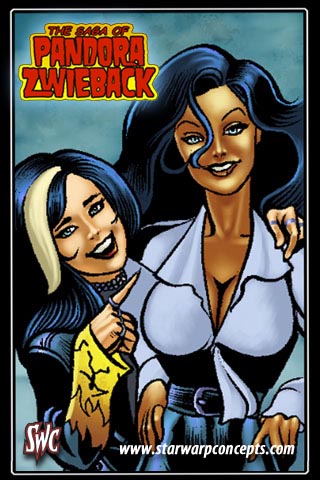Continuing the history of StarWarp Concepts, which is celebrating its 30th anniversary this year. When we left off, 1996 had seen the return of our resident succubus, Lorelei, in the aptly named Lorelei Returns! Special from indie house Power Comics…only for PC to fold shortly after the special’s publication.
Now, with no comic ptojects on the horizon, perhaps StarWarp Concepts’ future didn’t lie in comic books, as I’d originally set out to publish. Maybe the literary market was a direction to go in to find success—and what better way than to find a major book company to perhaps publish a brand-new project…?
(I know I told this story back in January 2021, to mark the passing of publishing industry giant Michael Z. Hobson, but his part in the history of the project that became The Saga of Pandora Zwieback is a major one, as you’ll see.)

It all started in 1997, during my time as a book editor, when my boss at the time, Byron Preiss, had hired Michael Z. Hobson to be executive vice president of publishing for his Byron Preiss Multimedia Company, which not only produced screensavers and the like but also co-published a highly successful line of original novels and anthologies based on the Marvel Comics characters.
Mike and I got along really well. He was an easily likeable guy: he didn’t put on the sort of superior attitude you’d expect from someone who’d been in the business as long as he had, and who’d been a top-level executive for just as long—a Harvard graduate, he’d been a literary agent, and an executive at Little, Brown and Company and Scholastic Publishing before joining Marvel Comics as an executive vice president from 1981 to 1994.
Mike was attentive, encouraging, and a firm believer in letting creative people be creative. It was those qualities that made him one of the most respected people in publishing; adding Mike to your roster was considered a major get.
Unfortunately, it didn’t take Mike very long to discover that as EVP he wasn’t really allowed to make a lot of final decisions; as president and publisher, Byron held on to that position. Over time, Mike grew tired of the situation and decided to move on—the line of wellwishers on his last day stretched down the hall.
In 1998, there was news that he’d landed as the new president of Parachute Properties, whose book-packaging company, Parachute Publishing, was the home of R.L. Stein’s bestselling Goosebumps and Fear Street series. That summer, after he’d had time to settle in, I got a call from Mike, and an invitation to lunch. Hey, who was I to turn down a free meal?
At a bistro not far from Parachute’s offices, Mike explained the reason for the get-together: he was looking for new titles. As he put it, he’d sat down with management and told them that Goosebumps and Fear Street were all well and good, but if Parachute was to remain successful, it needed to expand its lineup, and that meant bringing in outside projects—creator-owned outside projects.
That was a huge step. Book-packaging companies like Parachute—as well as Byron’s Byron Preiss Visual Publications—typically owned the projects they assembled, and hired authors and artists through work-for-hire contracts, which meant that what they wrote and drew was wholly owned by the company. For a packaging company to start offering deals in which they were profit participants on projects but owned no part of them would be a game changer.
Mike went on to remind me that he greatly enjoyed my writing and my approach to editing, which was why, given the praise he’d just heaped on me, I thought he might be headhunting me to join him as a Parachute editor. But he had an even better proposal to offer:
“So…do you have any project of your own you think would fit in at Parachute?”
Well, no, but that didn’t mean I wouldn’t have one for him in record time!
A couple weeks later I presented him with Heartstopper, a proposed six-book series of young-adult novels starring an immortal monster hunter named Sebastienne Mazarin and her teenaged Goth-girl sidekick, Pandora Zwieback. I even included character designs, courtesy of Pan and Annie’s co-creator, artist Uriel Caton, who had collaborated with me on the original-but-failed Heartstopper mature-readers comic published in 1994. (Hey, there’s nothing wrong with recycling a title and a character and adding a teen assistant to get it into the YA market. Oh, and you can download those issues for free, by the way.)

Mike loved it. He especially loved the title—Heartstopper was a short, memorable title like Goosebumps, easy to sell. Even more, he immediately saw its potential—not just YA books, but comics, movies, TV shows, merchandising…yes, this was exactly the sort of new Parachute title he was looking for. By mid-1999, after some fine-tuning of the proposal and a series of editorial back-and-forths, a deal was reached and contracts signed—Heartstopper was now one of the half dozen (or so) creator-owned properties that Parachute Publishing was going to package. Even better, Mike had put me in touch with one of the other property owners, an artist who needed a writer to help develop his storyline; so now I was looking at two writing projects!
“Off we go!” Mike wrote in his cover letter to the final executed agreement.
But then a few months later, I got another call from Mike, and another invitation to lunch. When we got together, Mike explained he had some very bad news to deliver: the new line of books was being scuttled. He couldn’t tell me exactly why that was—that was in-house politics not open for discussion with outsiders—but my impression was that Parachute soured on the idea that they weren’t going to own any of these new properties and thereby reap all the benefits. And possibly they hadn’t realized at the start just how successful Mike would be in launching his plans, or how quickly he’d be able to line up talent for them.
So now they were killing the program, and Mike was placed in the position of having to go back to all us creators and apologize for having us do all this work for no reward. (Since we owned the properties, none of the creators were paid for developing them; the money would have come from eventual sales and a 50/50 split with Parachute. But we all understood that going in.)
For someone with Mike’s standing in the industry, it was a major embarrassment.
The good news, though, was that with the publishing deals dead the creators were free and clear to do what we liked with our projects, hopefully finding homes for them at other publishing houses. Mike even later reached out to some of his contacts to see if Heartstopper could land somewhere (unfortunately, everyone passed on it).
Heartstopper the YA book series never did find a home, but its stars, Sebastienne Mazarin and Pandora Zwieback, would eventually make their literary debut. It would just take some time for it to happen…






